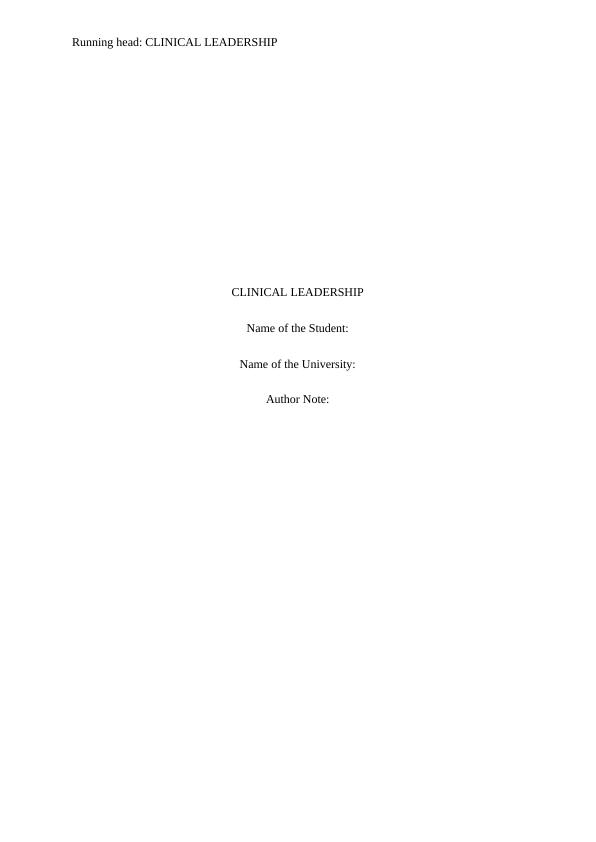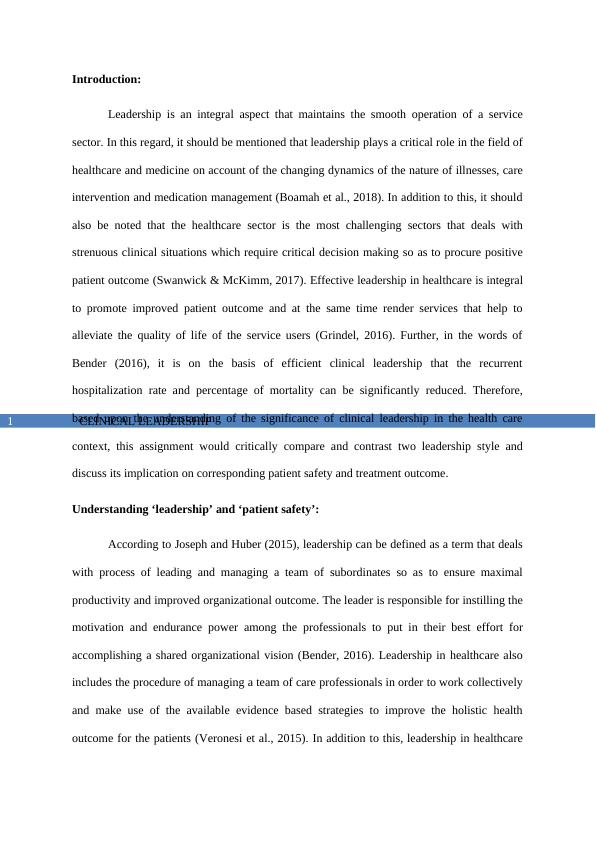Clinical Leadership
Added on 2022-12-05
9 Pages2291 Words277 Views
Running head: CLINICAL LEADERSHIP
CLINICAL LEADERSHIP
Name of the Student:
Name of the University:
Author Note:
CLINICAL LEADERSHIP
Name of the Student:
Name of the University:
Author Note:

CLINICAL LEADERSHIP1
Introduction:
Leadership is an integral aspect that maintains the smooth operation of a service
sector. In this regard, it should be mentioned that leadership plays a critical role in the field of
healthcare and medicine on account of the changing dynamics of the nature of illnesses, care
intervention and medication management (Boamah et al., 2018). In addition to this, it should
also be noted that the healthcare sector is the most challenging sectors that deals with
strenuous clinical situations which require critical decision making so as to procure positive
patient outcome (Swanwick & McKimm, 2017). Effective leadership in healthcare is integral
to promote improved patient outcome and at the same time render services that help to
alleviate the quality of life of the service users (Grindel, 2016). Further, in the words of
Bender (2016), it is on the basis of efficient clinical leadership that the recurrent
hospitalization rate and percentage of mortality can be significantly reduced. Therefore,
based upon the understanding of the significance of clinical leadership in the health care
context, this assignment would critically compare and contrast two leadership style and
discuss its implication on corresponding patient safety and treatment outcome.
Understanding ‘leadership’ and ‘patient safety’:
According to Joseph and Huber (2015), leadership can be defined as a term that deals
with process of leading and managing a team of subordinates so as to ensure maximal
productivity and improved organizational outcome. The leader is responsible for instilling the
motivation and endurance power among the professionals to put in their best effort for
accomplishing a shared organizational vision (Bender, 2016). Leadership in healthcare also
includes the procedure of managing a team of care professionals in order to work collectively
and make use of the available evidence based strategies to improve the holistic health
outcome for the patients (Veronesi et al., 2015). In addition to this, leadership in healthcare
Introduction:
Leadership is an integral aspect that maintains the smooth operation of a service
sector. In this regard, it should be mentioned that leadership plays a critical role in the field of
healthcare and medicine on account of the changing dynamics of the nature of illnesses, care
intervention and medication management (Boamah et al., 2018). In addition to this, it should
also be noted that the healthcare sector is the most challenging sectors that deals with
strenuous clinical situations which require critical decision making so as to procure positive
patient outcome (Swanwick & McKimm, 2017). Effective leadership in healthcare is integral
to promote improved patient outcome and at the same time render services that help to
alleviate the quality of life of the service users (Grindel, 2016). Further, in the words of
Bender (2016), it is on the basis of efficient clinical leadership that the recurrent
hospitalization rate and percentage of mortality can be significantly reduced. Therefore,
based upon the understanding of the significance of clinical leadership in the health care
context, this assignment would critically compare and contrast two leadership style and
discuss its implication on corresponding patient safety and treatment outcome.
Understanding ‘leadership’ and ‘patient safety’:
According to Joseph and Huber (2015), leadership can be defined as a term that deals
with process of leading and managing a team of subordinates so as to ensure maximal
productivity and improved organizational outcome. The leader is responsible for instilling the
motivation and endurance power among the professionals to put in their best effort for
accomplishing a shared organizational vision (Bender, 2016). Leadership in healthcare also
includes the procedure of managing a team of care professionals in order to work collectively
and make use of the available evidence based strategies to improve the holistic health
outcome for the patients (Veronesi et al., 2015). In addition to this, leadership in healthcare

CLINICAL LEADERSHIP2
also requires the leader to possess effective communication skills such that the leader can
efficiently communicate with the team of professionals and work collectively to implement
the intervention that best suits the care needs of the patient (Joseph & Huber, 2015). In
addition to this, the leader also needs to effectively interact with the multidisciplinary team of
professionals in order to ensure that the holistic care needs of the patient is appropriately
addressed (Grindel, 2016). Research studies further mention that a nursing leader must also
possess emotional attributes of empathy and induce motivation among the team of
professionals so as to acquire improved performance output (Bender, 2016). Also, a leader
must be able to identify the existing weaknesses and incorporate measures to ensure
professional development such that quality of offered services also improve continuously
(Grindel, 2016).
A number of research studies have shown that efficient clinical leadership is directly
associated with improved patient safety and increased level of patient satisfaction with the
offered treatment services (Bender, 2016). According to Demeh and Rosengren (2015), an
efficient leader is able to direct the team of care professionals appropriately during times of
crisis or critical decision making such that the care outcome or safety of the service users is
not compromised. Also, Sarto and Veronesi (2016), stated that efficient clinical leadership
helps devise patient-centred care that is based on the consideration of evidence based
strategies to acquire improved patient outcome.
Anarchic/Autocratic leadership and Transformational leadership style:
In order to shortlist the two clinical leadership styles and discuss their implication on
patient safety, an exhaustive search was conducted on the electronic databases of Google
Scholar and Medline. The retrieved search results after incorporation of appropriate
inclusion/exclusion criteria, suggested that the two most prevalent leadership styles that were
also requires the leader to possess effective communication skills such that the leader can
efficiently communicate with the team of professionals and work collectively to implement
the intervention that best suits the care needs of the patient (Joseph & Huber, 2015). In
addition to this, the leader also needs to effectively interact with the multidisciplinary team of
professionals in order to ensure that the holistic care needs of the patient is appropriately
addressed (Grindel, 2016). Research studies further mention that a nursing leader must also
possess emotional attributes of empathy and induce motivation among the team of
professionals so as to acquire improved performance output (Bender, 2016). Also, a leader
must be able to identify the existing weaknesses and incorporate measures to ensure
professional development such that quality of offered services also improve continuously
(Grindel, 2016).
A number of research studies have shown that efficient clinical leadership is directly
associated with improved patient safety and increased level of patient satisfaction with the
offered treatment services (Bender, 2016). According to Demeh and Rosengren (2015), an
efficient leader is able to direct the team of care professionals appropriately during times of
crisis or critical decision making such that the care outcome or safety of the service users is
not compromised. Also, Sarto and Veronesi (2016), stated that efficient clinical leadership
helps devise patient-centred care that is based on the consideration of evidence based
strategies to acquire improved patient outcome.
Anarchic/Autocratic leadership and Transformational leadership style:
In order to shortlist the two clinical leadership styles and discuss their implication on
patient safety, an exhaustive search was conducted on the electronic databases of Google
Scholar and Medline. The retrieved search results after incorporation of appropriate
inclusion/exclusion criteria, suggested that the two most prevalent leadership styles that were

End of preview
Want to access all the pages? Upload your documents or become a member.
Related Documents
Leadership - Case Study Analysislg...
|11
|2925
|24
Comparison of Transformative and Autocratic Leadership Styles in Nursinglg...
|9
|2269
|61
(PDF) Clinical leadership: values, beliefs and visionlg...
|8
|2241
|51
Clinical Leadership and Profession Relationshiplg...
|8
|2113
|1
The clinical nurse leaderlg...
|11
|3285
|20
Teaching Learning And Leadership For Clinicallg...
|10
|2922
|21
